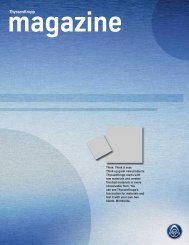TK Stainless
TK Stainless
TK Stainless
You also want an ePaper? Increase the reach of your titles
YUMPU automatically turns print PDFs into web optimized ePapers that Google loves.
ThyssenKrupp sTainless aG Research and development<br />
a material - Nicrofer 5520 Co B - which meets the increased thermal and corrosive requirements of<br />
these power plants; suitability for operating temperatures of 700°C has already been successfully<br />
demonstrated. Our engineers are now working on using this alloy for the manufacture of longitudinalwelded<br />
thick-wall pipes and large forgings.<br />
The transportation of liquefied gas offers an important source of alternative energy for the future.<br />
The VDM alloy Pernifer 36 is now to be used for the innermost coating of the longitudinal-welded<br />
pipe through which the gas flows to prevent major shrinkage of the pipes when cooling. The pipes<br />
are subject to high pressures and any defects could have fateful consequences. ThyssenKrupp VDM<br />
has therefore developed the welding filler metal Pernifer S 36 CrAl, an alloy containing additional<br />
elements to enhance strength and ensure good weldability. With low thermal expansion, the new<br />
material increases the strength of the weld.<br />
The use of nickel alloys is also paying dividends in wind turbines. Turbines with so-called hightemperature<br />
superconductors operate with much higher efficiency than conventional systems.<br />
Together with a development partner, ThyssenKrupp VDM has developed a production route for nickel<br />
W14 which can be used in superconductors, e.g. in generators, and provides mechanical stability<br />
and long service life. The findings gained in the laboratory were successfully transferred to largescale<br />
production; a patent has already been filed. This development opens up a new opportunity to<br />
participate in the growth of the wind power market.<br />
In the area of fuel cells, further progress was made in the development of a material for<br />
interconnector plates. The new material Crofer 22 H - like Crofer 22 APU, developed jointly with the<br />
Jülich Research Center - was produced for the first time on a commercial scale. Crofer 22 H is a<br />
material with much greater elevated-temperature strength than Crofer 22 APU. This is achieved by<br />
additions of niobium, tungsten and silicon. Samples of this new material are currently being supplied<br />
to customers working on developing the next generation of SOFC stack technology.<br />
ThyssenKrupp Titanium developed the titanium alloy Ti-X containing the relatively inexpensive<br />
main constituents of iron and silicon especially for use in auto exhaust systems. In contrast to pure<br />
titanium, which cannot be used at high temperatures, the new material is a high-temperature alloy<br />
which is oxidation-resistant and can be used at temperatures up to 750°C. To enable the material to be<br />
used at even higher temperatures up to 1,000°C, the company developed a special protective coating<br />
in the form of a thin aluminum cladding applied to the alloy. The test material is now available, further<br />
tests will follow shortly. The advantage of volume use of this material in auto manufacturing lies in its<br />
significantly lower weight which reduces CO2 emissions in vehicle operation.<br />
Aluminum seat rails, used mainly in damp areas of aircraft, are exposed to particularly heavy<br />
wear. In addition, the mechanically stressed rails are subject to corrosion damage. The solution: a<br />
low-weight composite material consisting of titanium and aluminum developed by ThyssenKrupp<br />
The new VOD unit will improve the quality of large<br />
ingots, e.g. for power plants.<br />
High-temperature<br />
superconductors are used<br />
in wind turbines.<br />
39

















